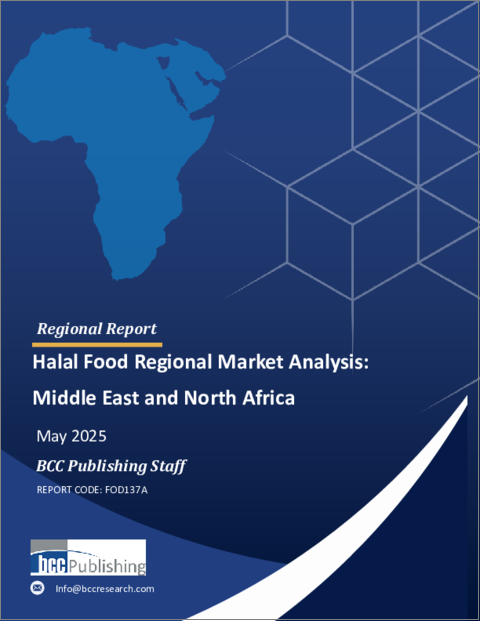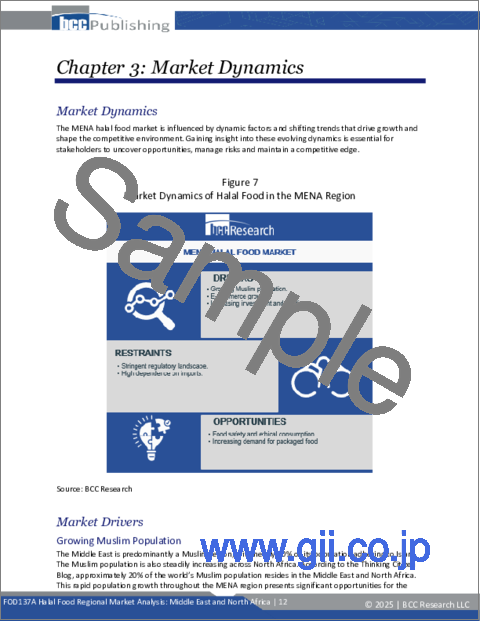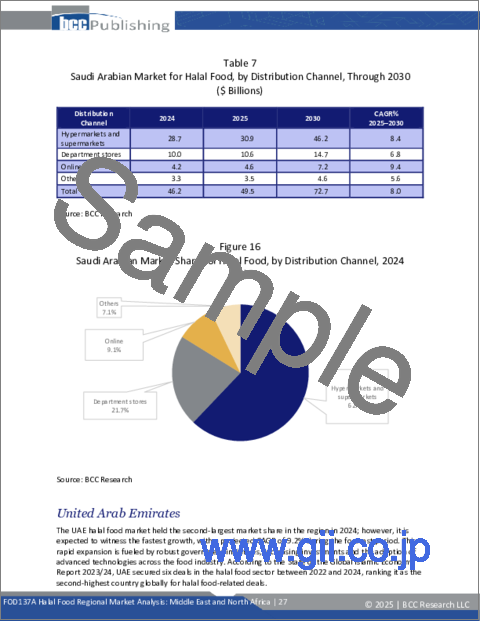|
|
市場調査レポート
商品コード
1735433
ハラール食品の地域市場分析:中東・北アフリカHalal Food Regional Market Analysis: Middle East and North Africa |
||||||
|
|||||||
| ハラール食品の地域市場分析:中東・北アフリカ |
|
出版日: 2025年05月15日
発行: BCC Research
ページ情報: 英文 51 Pages
納期: 即納可能
|
全表示
- 概要
- 図表
- 目次
当レポートでは、中東・北アフリカ地域のハラール食品の市場を調査し、市場概要、市場影響因子および市場機会の分析、法規制環境、市場規模の推移・予測、競合情勢、主要企業のプロファイルなどをまとめています。
目次
第1章 エグゼクティブサマリー
- 市場見通し
- 調査範囲
- 研究の理由
- 市場サマリー
第2章 中東・北アフリカ地域のハラール食品産業の展望
- ハラール食品の利点
- ハラール食品の進化
- 中東・北アフリカ地域のハラール食品市場のPESTEL分析
- ハラール食品に関する規制分析
- 世界のハラール食品市場:概要
- 中東・北アフリカ地域のハラール食品産業
第3章 市場力学
- 市場力学
- 市場促進要因
- イスラム教徒人口の増加
- Eコマースの成長
- 投資と資金調達の増加
- 市場の課題
- 厳格な規制状況
- 高い輸入依存度
- 市場機会
- 食品の安全と倫理的消費
- 包装食品の需要増加
第4章 市場セグメンテーション分析
- セグメンテーションの内訳
- 市場分析:製品タイプ別
- 市場分析:流通チャネル別
第5章 新興市場
- 中東・北アフリカ市場の分析 (国別)
- サウジアラビア
- UAE
- エジプト
- イラン
- GCC諸国
- その他
第6章 ロシア・ウクライナ戦争の影響分析
- 概要
第7章 競合情勢
- 概要
- 競合情勢
- 中東・北アフリカのハラール食品市場における主要サプライヤーおよび卸売業者
- BCCによる総論
第8章 付録
List of Tables
- Summary Table : MENA Market for Halal Food, by Country, Through 2030
- Table 1 : Key Regulations on Halal Food in MENA
- Table 2 : MENA Market for Halal Food, by Product Type, Through 2030
- Table 3 : MENA Market for Halal Food, by Distribution Channel, Through 2030
- Table 4 : MENA Market for Halal Food, by Country, Through 2030
- Table 5 : Saudi Arabian Market for Halal Food, by Value, Through 2030
- Table 6 : Saudi Arabian Market for Halal Food, by Product Type, Through 2030
- Table 7 : Saudi Arabian Market for Halal Food, by Distribution Channel, Through 2030
- Table 8 : UAE Market for Halal Food, by Value, Through 2030
- Table 9 : UAE Market for Halal Food, by Product Type, Through 2030
- Table 10 : UAE Market for Halal Food, by Distribution Channel, Through 2030
- Table 11 : Egyptian Market for Halal Food, by Value, Through 2030
- Table 12 : Egyptian Market for Halal Food, by Product Type, Through 2030
- Table 13 : Egyptian Market for Halal Food, by Distribution Channel, Through 2030
- Table 14 : Iranian Market for Halal Food, by Value, Through 2030
- Table 15 : Iranian Market for Halal Food, by Product Type, Through 2030
- Table 16 : Iranian Market for Halal Food, by Distribution Channel, Through 2030
- Table 17 : GCC Market for Halal Food, by Value, Through 2030
- Table 18 : GCC Market for Halal Food, by Product Type, Through 2030
- Table 19 : GCC Market for Halal Food, by Distribution Channel, Through 2030
- Table 20 : Rest of the MENA Market for Halal Food, by Value, Through 2030
- Table 21 : Rest of the MENA Market for Halal Food, by Product Type, Through 2030
- Table 22 : Rest of the MENA Market for Halal Food, by Distribution Channel, Through 2030
- Table 23 : Key Global Market Players in the Halal Food Industry
- Table 24 : Key Market Players in the MENA Halal Food Industry
- Table 25 : Strategic Developments in the MENA Halal Food Market
- Table 26 : Information Sources in this Report
- Table 27 : Abbreviations Used in this Report
List of Figures
- Summary Figure : MENA Market for Halal Food, by Country, 2024-2030
- Figure 1 : Key Trends in the Halal Food Market
- Figure 2 : Benefits of Halal Meat
- Figure 3 : Halal Food Evolution
- Figure 4 : Pestel Analysis of MENA Halal Food Market
- Figure 5 : Global Market for Halal Food, by Value, 2024-2030
- Figure 6 : MENA Share in Global Halal Food Market, by Value, 2024
- Figure 7 : Market Dynamics of Halal Food in the MENA Region
- Figure 8 : Muslim Population Growth in the Middle East and North Africa, 1990-2030
- Figure 9 : Investment in the MENA Region, by Sector, 2024
- Figure 10 : Growth of Halal Food Imports in OIC Countries, 2022-2024
- Figure 11 : MENA Market Shares of Halal Food, by Product Type, 2024
- Figure 12 : MENA Market Shares of Halal Food, by Distribution Channel, 2024
- Figure 13 : MENA Market Shares of Halal Food, by Country, 2024
- Figure 14 : Saudi Arabian Market for Halal Food, by Value, 2024-2030
- Figure 15 : Saudi Arabian Market Shares of Halal Food, by Product Type, 2024
- Figure 16 : Saudi Arabian Market Shares of Halal Food, by Distribution Channel, 2024
- Figure 17 : UAE Market for Halal Food, by Value, 2024-2030
- Figure 18 : UAE Market Shares of Halal Food, by Product Type, 2024
- Figure 19 : UAE Market Shares of Halal Food, by Distribution Channel, 2024
- Figure 20 : Egyptian Market for Halal Food, by Value, 2024-2030
- Figure 21 : Egyptian Market Shares of Halal Food, by Product Type, 2024
- Figure 22 : Egyptian Market Shares of Halal Food, by Distribution Channel, 2024
- Figure 23 : Iranian Market for Halal Food, by Value, 2024-2030
- Figure 24 : Iranian Market Shares of Halal Food, by Product Type, 2024
- Figure 25 : Iranian Market Shares of Halal Food, by Distribution Channel, 2024
- Figure 26 : GCC Market for Halal Food, by Value, 2024-2030
- Figure 27 : GCC Market Shares of Halal Food, by Product Type, 2024
- Figure 28 : GCC Market Shares of Halal Food, by Distribution Channel, 2024
- Figure 29 : Rest of the MENA Market for Halal Food, by Value, 2024-2030
- Figure 30 : Rest of the MENA Market Shares of Halal Food, by Product Type, 2024
- Figure 31 : Rest of the MENA Market Shares of Halal Food, by Distribution Channel, 2024
The report provides an analysis of the Middle East and North Africa (MENA) halal food market. Using 2024 as the base year, the report provides estimated market data for 2025 through 2030. It explores various market drivers, such as technological developments, economic influences and strategic business factors. The countries included in the analysis are Saudi Arabia, the United Arab Emirates, Egypt, Iran, the GCC (Gulf Cooperation Council) countries (Qatar, Bahrain, Oman, and Kuwait), and the rest of the MENA region.
Report Scope
This report provides an in-depth analysis of the halal food market across the Middle East and North Africa (MENA) region, using 2024 as the base year and offering forecasts through 2030, including projected compound annual growth rates (CAGR). It explores various market drivers, such as technological developments, economic influences and strategic business factors. The study organizes the halal food market by product type and distribution channels and examines the dynamics of the countries that shape the regional halal food industry. The countries included in the analysis are Saudi Arabia, the United Arab Emirates, Egypt, Iran, the GCC (Gulf Cooperation Council) countries (Qatar, Bahrain, Oman, and Kuwait), and the rest of the MENA region.
Turkey and Israel have been intentionally excluded from the scope of this report due to the advanced maturity of their halal food sectors compared to other MENA countries. Including these markets would distort the overall analysis, making it less relevant to understanding the unique opportunities and challenges within the region's emerging halal food markets. This focused approach provides a clearer picture for businesses and investors aiming to tap into the MENA halal food industry's less-developed, potentially high-growth areas.
Report Includes
- An in-depth analysis of the halal food market in the Middle East and North Africa (MENA) region
- Analyses of the trends in MENA market, with revenue data for 2024, estimates for 2025, and projected CAGRs through 2030
- Estimates of the market size and revenue prospects, accompanied by a market share analysis by food type, sales channel and country
- Facts and figures pertaining to the current market dynamics, technological advances, regulations and the impact of macroeconomic factors
- Analysis of the industry structure, including key stakeholders' market shares, product mapping and recent key developments
- An assessment of the sustainability trends and ESG developments in the market
Table of Contents
Chapter 1 Executive Summary
- Market Outlook
- Scope of Report
- Reasons for the Study
- Market Summary
Chapter 2 MENA Halal Food Industry Outlook
- Benefits of Halal Food Products
- Evolution of Halal Food
- Pestel Analysis of MENA Halal Food Market
- Regulatory Analysis for Halal Food
- Global Halal Food Market Overview
- MENA Halal Food Industry
Chapter 3 Market Dynamics
- Market Dynamics
- Market Drivers
- Growing Muslim Population
- E-Commerce Growth
- Increasing Investment and Funding
- Market Challenges
- Stringent Regulatory Landscape
- High Import Dependency
- Market Opportunities
- Food Safety and Ethical Consumption
- Increasing Demand for Packaged Food
Chapter 4 Market Segmentation Analysis
- Segmentation Breakdown
- Market Analysis, by Product Type
- Market Analysis, by Distribution Channel
Chapter 5 Emerging Markets
- MENA Market Analysis, by Country
- Saudi Arabia
- United Arab Emirates
- Egypt
- Iran
- Gulf Cooperation Council
- Rest of the MENA Region
Chapter 6 Russia-Ukraine War Impact Analysis
- Overview
Chapter 7 Competitive Landscape
- Overview
- Competitive Landscape
- Leading Suppliers and Wholesalers in the MENA Halal Food Market
- Concluding Remarks from BCC
Chapter 8 Appendix
- Methodology
- Sources
- Abbreviations





